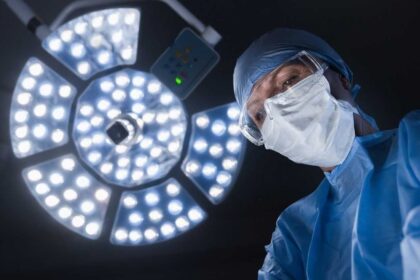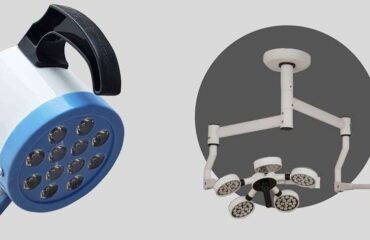
Hospital O.T. (Operation Theatre) & Examination Lights are specialized lighting systems designed for medical use, particularly in surgical and diagnostic procedures. These lights provide high-quality illumination to ensure visibility and precision during medical interventions. Below is an overview of their features and purposes:
Operation Theatre (O.T.) Lights:
O.T. lights are critical in surgical environments, providing consistent and shadow-free illumination for intricate procedures.
Features:
- High Intensity: Ensures clear visibility of the surgical site.
- Shadow Reduction: Designed to minimize shadows caused by surgical staff or instruments.
- Color Rendering Index (CRI): High CRI ensures accurate visualization of tissues and blood.
- Adjustable Brightness: Allows surgeons to control light intensity as needed.
- Cool Lighting: Modern T. lights use LED or halogen technology to minimize heat production, preventing discomfort to patients and staff.
- Sterile Control: Enables adjustments without compromising sterility.
- Multiple Configurations: Available in ceiling-mounted, wall-mounted, or portable designs, often with multiple heads for better coverage.
Types of O.T. Lights:
- LED O.T. Lights: Energy-efficient and long-lasting.
- Halogen O.T. Lights: Traditional, less energy-efficient but still in use.
- Single Dome or Double Dome Lights: Based on the size and coverage requirements of the operation theatre.
Examination Lights:
These lights are used for general medical examinations, minor procedures, and diagnostic purposes in outpatient departments, clinics, and emergency rooms.
Features:
- Focused Illumination: Provides concentrated light for small areas.
- Portability: Often lightweight and mobile for flexibility.
- Adjustable Arm and Angle: Allows precise positioning during use.
- Cool Light Technology: Reduces heat to avoid patient discomfort.
- Energy Efficiency: LED technology is commonly used for low power consumption.
Applications:
- General physical examinations.
- Dermatological assessments.
- Minor surgical procedures, such as suturing.
- Gynecological or ENT examinations.
What is the importance of O.T. & Examination Lights in Health care?
The Importance of O.T. (Operation Theatre) & Examination Lights in Healthcare is critical as they directly impact the precision, safety, and efficiency of medical procedures. Below are the key reasons why these lights are indispensable in healthcare settings:
Ensuring Accurate Diagnosis and Treatment
- Enhanced Visibility: Both O.T. and examination lights provide clear, bright, and focused illumination, allowing healthcare professionals to accurately diagnose and treat patients.
- Color Accuracy: High Color Rendering Index (CRI) ensures tissues, blood, and organs are seen in their true colors, crucial for identifying abnormalities.
Supporting Precision in Surgical Procedures
- Shadow-Free Illumination:T. lights are designed to eliminate shadows caused by surgical instruments or personnel, ensuring uninterrupted visibility.
- Focus on Details: Surgeons require clear visualization of fine anatomical details, which is facilitated by high-intensity, adjustable lighting.
Maintaining Sterility and Hygiene
- Hands-Free Adjustments: T. lights often feature sterile control systems, enabling adjustments without compromising the sterile field.
- Minimal Heat Generation: Modern LED-based lights reduce heat output, preventing microbial growth and ensuring patient comfort.
Enhancing Patient Comfort
- Cool Light Technology: Examination lights produce minimal heat, reducing discomfort during diagnostic or minor surgical procedures.
- Non-Intrusive Design: Adjustable intensity and positioning make these lights less invasive during examinations.
Versatility Across Medical Specialties
O.T. and examination lights are used in various disciplines:
- Surgery: For major operations in orthopedics, neurology, and general surgery.
- Gynecology: To illuminate the pelvic area for precise diagnostics or procedures.
- Dermatology: For skin examinations and minor procedures.
- Emergency Rooms: For immediate assessment and treatment of critical cases.
Safety and Efficiency
- Reduced Fatigue: Proper lighting minimizes eye strain for medical staff during long procedures, reducing errors and improving outcomes.
- Energy Efficiency: LED technology ensures lower power consumption and longer lifespan, contributing to cost savings and environmental benefits.
Compliance with Standards
- High-quality O.T. and examination lights meet stringent healthcare standards, ensuring the safety and effectiveness of medical care delivery.

